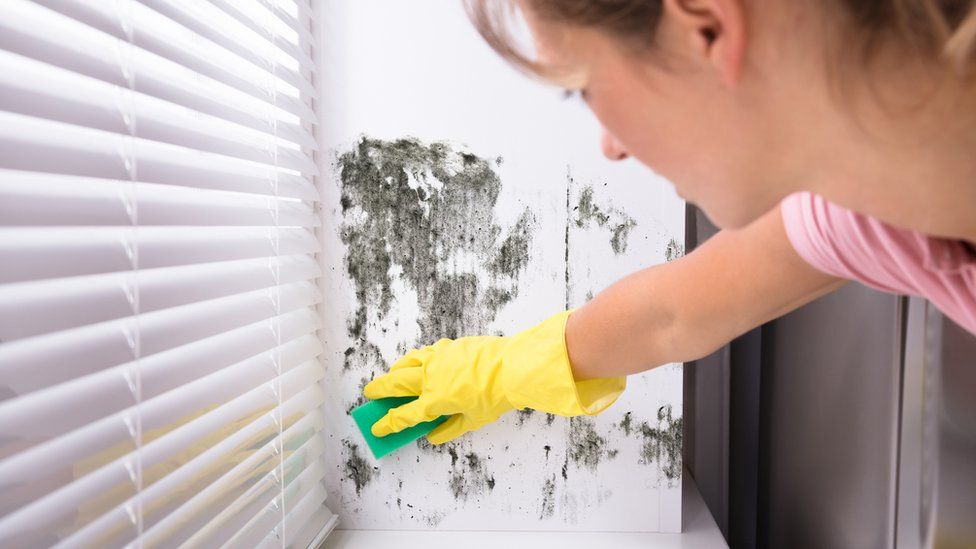ARTICLE AD BOX
 Image source, Getty Images
Image source, Getty Images
Exposure to mould in the home can be damaging to your health.
But what exactly is mould, when is it harmful, and what can be done about it in your house?
What is mould?
Mould is a microscopic fungus that grows in damp places. Mould spores are found everywhere, and are released in their thousands into the atmosphere.
Signs of mould at home include fuzzy black, white or green patches on the walls, and a damp and musty smell.
Mould and damp in houses is more dangerous when temperatures drop in the winter.
How can mould affect your health?
People living with mould are more likely to suffer from respiratory illnesses, infections, allergies or asthma.
Mould can emit spores, cells, fragments and "volatile organic compounds" into the air.
Inhaling or touching these spores can cause an allergic reaction, such as sneezing, a runny nose, red eyes and skin rash.
Moulds can also trigger asthma attacks and cause coughing, wheezing and breathlessness.
"[Even] people who don't have asthma can develop an allergic response," according to Dr Andy Whittamore, a GP who works with the charity Asthma and Lung UK.
"In some cases, mould can be breathed in and can be found growing in the lungs - it can be life-threatening."
Those more at risk include the elderly, children and babies, people with existing respiratory illnesses and people with some skin problems.
Mould can also be more dangerous for people with a weakened immune system, either due to illness or because of medicines they are taking.
What causes mould in buildings?
Condensation is the leading cause of mould in homes across the UK.
It most commonly occurs in parts of the home where there are high moisture levels - in bathrooms, kitchens, and around windows.
When the temperature falls to a level known as the dew point, water vapour in the air forms into water droplets.
If water vapour comes into contact with a surface in the home that's below the dew point, such as an uninsulated external wall or a cold window, then water droplets will form.
If left untreated, the surface can become damp and create the conditions for mould to grow.
Catherine Noakes, professor of Environment Engineering for Buildings at the University of Leeds, said older and poorly insulated properties are more prone to this.
Mould can also be caused by daily tasks which create excess moisture.
"Sometimes it's occupant behaviour - things that we all do and we cannot change," Prof Noakes said.
"We all shower, we all cook, and we all dry washing at home."
Prof Noakes warned that mould conditions could be made worse this winter if people don't put on the heating because of high energy bills.
Image source, Greater Manchester Police
Image caption,Mould growing in the home of Awaab Ishak, who died aged two
How to prevent mould
In severe cases, Prof Noakes said there are limits to what occupants can do.
However, in less serious cases, there are things that can help, from taking shorter showers to improving ventilation in the property.
"The shorter the shower, the less moisture there is," Prof Noakes said.
She also suggests wiping down the shower afterwards, rather than leaving the water to evaporate.
Open kitchen windows or use an extractor fan when cooking.
It is also important to check for obvious problems such as leaky pipes or gutters which could be contributing to the problem.
What rights do tenants have?
Private and social landlords have a responsibility to make sure homes are fit for habitation.
If you are living in a rented property, it is the landlord's responsibility to fix a mould problem if it is caused by poor maintenance, according to the housing charity Shelter.
"Where the mould is caused by disrepair or the property is unfit for habitation - for example, as a result of damp or condensation caused by poor insulation or faulty heating or ventilation systems - then it is the landlord's responsibility to fix it," said John Gallagher, from the charity.
If the mould is so bad that it makes your home unfit for habitation, then you could be classed as homeless and entitled to emergency accommodation, he added.
But Mr Gallagher said if there is evidence a tenant is not ventilating the home correctly, then the landlord may not be responsible.

 2 years ago
45
2 years ago
45








 English (US) ·
English (US) ·